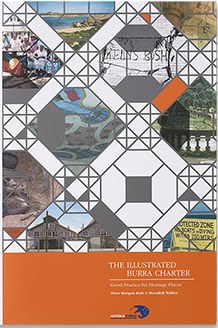Burra Charter
The Burra Charter defines the basic principles and procedures to be followed in the conservation of Australian heritage places.
 The Illustrated Burra Charter 2004 | |
| Author | Meredith Walker |
|---|---|
| Language | English |
| Genre | Non Fiction |
| Published | 2013 |
| Publisher | Australia/ICOMOS Peter Marquis-Kyle |
| Publication place | Australia |
| Media type | Print (paperback) |
| ISBN | 0-9578528-2-7 |
In 1979, the Australia ICOMOS Charter for the Conservation of Places of Cultural Significance was adopted at a meeting of Australia ICOMOS (International Council on Monuments and Sites) at the historic mining town of Burra, South Australia.[1] It was given the short title of The Burra Charter.
The Charter accepted the philosophy and concepts of the ICOMOS Venice Charter, but wrote them in a form which would be practical and useful in Australia. The Charter is periodically revised and updated, and the 2004 publication The Illustrated Burra Charter[2] elaborates and explains the principles of the 1999 version in an easy to understand form. In 2013 the Charter was again revised and updated, and is available online here.
The Burra Charter has been adopted by the Australian Heritage Council (December 2004), the Heritage Council of New South Wales (December 2004), the Queensland Heritage Council (January 2005) and the Heritage Council of Victoria (July 2010).[3] It is also recommended by the Heritage Council of Western Australia[4] and the Tasmanian Heritage Council.[5]
The Burra Charter is especially useful when places with a high level of significance are proposed to be conserved or changed in some way, such as when restoring a house museum or changing the use of an historic public building. It is not so useful for everyday cases such as historic home renovation, and is rarely applied in that situation in Australia.
Importance
The Burra Charter is recognised as having pioneered the understanding of cultural heritage as going beyond the mere preservation of the built environment.[6]
- "To Australians, the Burra Charter is probably the most significant document of the last thirty years on the basic principles and procedures for the conservation of heritage places. It provides a guiding philosophy for the care of our heritage and has been widely adopted as the standard guidelines for heritage conservation practice not only in this country, but also in other parts of the world." - Heritage Perth [7]
Contents
The Burra Charter begins with a series of definitions, such as :
- Cultural significance means aesthetic, historic, scientific, social or spiritual value for past, present or future generations.
- Conservation means all the processes of looking after a place so as to retain its cultural significance.
The types of actions that might be taken in the Conservation of a heritage place are defined as :
- Preservation: Maintaining a place in its existing state and preventing further deterioration.
- Restoration:Returning a place to a known earlier state earlier state by removing accretions or by reassembling existing elements without the introduction of new material.
- Reconstruction: Returning a place to a known if there is sufficient evidence. and is distinguished from restoration by the introduction of new material.
Article 3.1 contains the often quoted summary that :
- Conservation....requires a cautious approach of changing as much as necessary but as little as possible.
Article 22 regarding New Work includes the often quoted but misunderstood recommendation that :
- New work should be readily identifiable as such, but must respect and have minimal impact on the cultural significance of the place.
This is often interpreted to mean that new work should be starkly different and modern, but the Illustrated Burra Charter explains that :
- Designing a new addition in a modern manner desirable, but not an excuse to make the new work dominate, or draw attention away from the existing place.
The final page is a section summarising the Burra Charter Process, as outlined in Article 6 :
Understand Significance
|
Develop Policy
|
Manage in Accordance with Policy
|
References
- ^ SA Department of Environment, Water & Natural Resources > The Burra Charter Retrieved 9 January 2014.
- ^ "Illustrated Burra Charter". australia.icomos.org. Retrieved 2019-08-15.
- ^ Australia ICOMOS > The Burra Charter Full text of the 2013 revised version of the Burra Charter. Retrieved 9 January 2014.
- ^ Heritage Council of Western Australia > Burra Charter? Retrieved 6 April 2017.
- ^ >%20Publications Heritage Tasmania > Publications Retrieved 16 August 2011.
- ^ Gilmour, Tony (2007). Sustaining Heritage: Giving the Past a Future. Sydney: Sydney University Press. p. 155.
- ^ Heritage Perth > The Burra Charter Retrieved 16 August 2011.
External links
- Understanding The Burra Charter Excerpts from an Australia ICOMOS brochure explaining the principles of heritage conservation. Retrieved 15 August 2011.
- The Burra Charter, 2013 revision.
